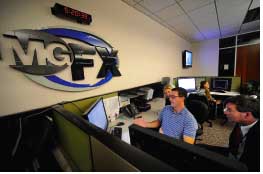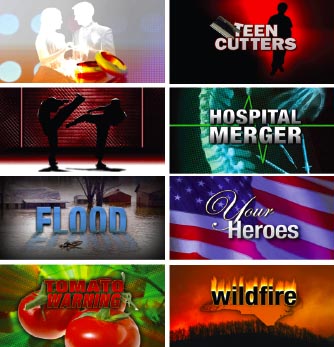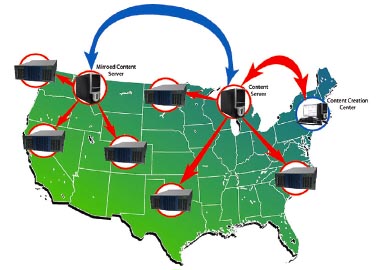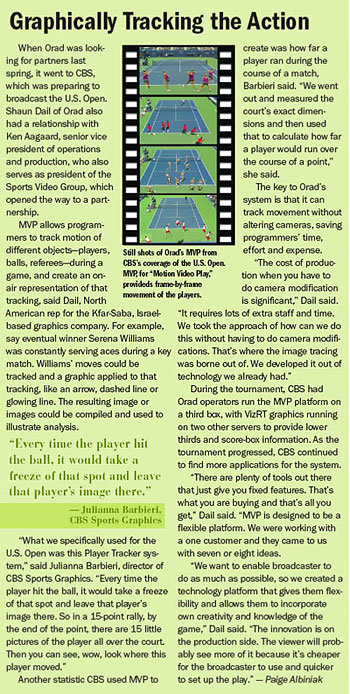More Than One Way to Skin a Graphic
Centralized, workflow-based graphics arrived on the broadcast scene in May 2003, when NBC created ArtHouse in Dallas/Ft. Worth. Based on Proximity's Artbox—a suite of content creation, management and workflow tools now owned by Apple and rolled into Final Cut Server—NBC developed an innovative and efficient way to create, distribute and broadcast graphics.

MGFX Senior Designer Phillip Mathers demonstrates template creating using Miranda's Vertigo Xstudio application."We had divergent business needs at the time," said David Steel, vice president of NBC Universal ArtWorks and the system's primary architect. "We needed to save some money and gain efficiencies, while improving the quality of our graphics, getting more animations on our air and improving the speed-to-air time for all of our graphics. It seemed counterintuitive at the time, but our solution ended up meeting all of our objectives."
Today, NBC has expanded ArtHouse into ArtWorks, covering five parts of its media business: NBC News; NBC Sports (excluding the Olympics); NBC East Coast Entertainment, which includes "Late Night with Conan O'Brien" and "Saturday Night Live;" MSNBC; CNBC; and the NBC-owned TV stations, which still are served out of the Dallas hub.
ArtWorks remains the country's largest centralized graphics system, but what was a leading-edge experiment in 2003 is becoming commonplace today.

Examples of new content generated by MGFX artists."The key driver right now for broadcast groups is return on investment," said Brian Olson, business development director of graphics and master control at Miranda Technologies in Wallingford, England. Centralized graphics "makes sense when you have four stations, and it makes a hell of a lot more sense if you have 30."
To that end, Media General has created MGFX, a centralized graphics hub that serves all of Media General's stations from Richmond, Va., based on Miranda's Xmedia Suite. Jim Doyle is general manager of Media General's MGFX operation. He helped NBC create ArtHouse in 2003.
"When we were doing that, we realized that a work-order system was central to the operation," he said. "It allows you to have an orderly system for submitting work. I ran a graphics department for years where we would take work orders scribbled on napkins or might just be delivered via a phone call, with no record. Now we have a standardized workflow that lets us track all our work."
Media General put out a request for proposal for precisely the system they wanted to build in February 2007 and found that "Miranda had a working work-order management system in place while other vendors did not," said John Atteberry, the MGFX director of operations. Doyle was brought on to implement and run the new system in September 2007.
DEVELOPMENT ON THE FLY
Miranda's work-order management system allows Media General's producers to work in a "just-in-time" environment, Doyle said.
For example, if a producer at Media General-owned WFLATV in Tampa Bay, Fla., wants to insert an image into an over-the-shoulder graphic, she inputs that request into the Miranda system. An artist fills the order, inserting the graphic into the correct template and into the broadcast's playlist for play-out. The producer gets notified the job was completed and can scan the play-out list to make sure the graphic was created correctly.
The system allows the producer to track the graphic at every step along the way, whether it's a complicated piece of art undergoing several revisions or a quick, lower-third graphic that's created and sent to air within minutes.

The Harris Inscriber Connectus system started life as a digital signage content management system. It evolved into a system that links Harris and third-party graphics projects within a given work environment.Once the order is completed, the graphic becomes permanently available in Media General's hubbed database for future use by any producer or designer in Media General's network. Miranda continued to respond to Media General's requests for customization after the deal was done. Miranda partnered with Thomson Grass Valley to develop an Xmedia interface for TGV's Ignite automated production system.
It also developed a way for Xmedia to handle attachments at Media General's request. And it developed a new compression scheme—the Vertigo Animation Format, or VAF—that allows the company to deliver high-res HD graphics or clips to stations very quickly.
"VAF allows us to take a 2 GB file of animations and crunch them down to about 150 to 200 MB," Miranda's Olson said. "It makes them a lot easier to transport over a network and easier to store."
Other features incorporated into the system let Media General stations feed live data into on-screen crawls, for example, and to create graphics of any size and shape, from full-screen HD broadcast graphics to banner graphics for station Web sites
"We expect this system to pay for itself in less than three years," Doyle said. With graphics driving the demand for robust workflows, Harris began offering Inscriber Connectus last summer. It connects all Harris and third-party graphics projects within a given work environment, said Brian App, Harris business development manager in graphics.
"Whether it's branding, automated subchannels, sports, news, you name it, if it's graphic, we handle it," he said.
Connectus started life as a content management system for digital signage, providing graphics and videos to digital signs in gas stations, airports, banks and the like. That system became part of Harris Icon Series branding solution. Now it's integrated with Harris' Inscriber MOS-based newsroom systems, character generators and clipstores.

It incorporates archival systems and search capabilities. Connectus can either be a seamless part of Harris Inscriber content creation software systems, or it can work with third-party graphics software products such as Adobe Photoshop and After Effects or Autodesk 3ds Max. Once content is created, it's published to the Connectus server, where it's ready to be viewed, edited and approved for playout.
REDUNDANCY WITH MIRRORS
To overcome bandwidth issues, Connectus uses a mirroring system so that graphics can reside on one server in the system, and then be mirrored by other servers across the system. Local stations connect to the local, mirrored servers. When revisions are made, only the changes are stored, freeing up storage space and speeding save time.
Finally, Chyron offers Axis, an Internet-based system that allows producers, designers and journalists to quickly create template-based graphics on the fly from anywhere and everywhere and distribute them over the Internet to TV stations, Web sites or mobile streaming operations.
"With today's economy being what it is, many people are being tasked with trying to economize and come up with efficiencies. With Axis, the focus is on ease of use," said Todd Martin, Chyron's vice president of operations for Axis.
Axis not only allows producers to create graphics for HD and SD broadcasts, but it also can resize formats to fit Web sites or mobile applications. And, using a newly developed feature called Instant Ingest, the system can even take photos snapped on cell phone cameras and automatically convert them into broadcast-ready images.
That's become a really effective feature for stations," Martin said.
In July, Gannett became the first broadcast group to announce a multiyear subscription to Chyron's Axis service, which allows stations to create all sorts of graphics—news, sports, weather, election results, maps, photos and so forth—from an online database of photo and graphics assets, as well as templates.
"[Chyron's] server-based model is designed to allow us to create more graphics, at a higher median quality, and at a lower cost. That would be a triple win," said David Lougee, president of Gannett Broadcasting Group in a statement.
Gannett is using Axis to easily and quickly create daily breaking-news graphics, maps and charts, while it leaves more complex graphics work to designers in its graphics hub, the Gannett Graphics Group, or G3 for short. Because it's Internet-based, Axis itself is almost as flexible as the services it provides.
"The good thing about Web-based products is that they are constantly evolving," said Martin, who notes that Axis Pro is coming in early 2009. "We can update the product whenever. We're constantly creating and doing things locally and all of our customers get to take advantage of that."
The professional video industry's #1 source for news, trends and product and tech information. Sign up below.
